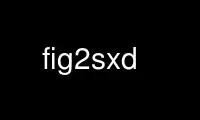
This is the command fig2sxd that can be run in the OnWorks free hosting provider using one of our multiple free online workstations such as Ubuntu Online, Fedora Online, Windows online emulator or MAC OS online emulator
PROGRAM:
NAME
fig2sxd - utility to convert .fig to .sxd
SYNOPSIS
fig2sxd [-w] [-l(ine)w(idth)1 l] figfile sxdfile
DESCRIPTION
The program tries to convert the given file in xfig format into a sxd file for
OpenOffice.org Draw. If figfile ends with .fig or .xfig and sxdfile is omitted, the output
file will be named like figfile ending with .sxd instead of .(x)fig. Using - for figfile
makes the program read from stdin so that it is possible to use
pstoedit -f fig file.ps - | fig2sxd - file.sxd
to convert ps files. (For files with many objects you might want to use something like
pstoedit -f 'fig:-startdepth 9999' file.ps - | fig2sxd - file.sxd
to get more layers; the output of pstoedit then is no longer a valid xfig file, but it
makes the z ordering of the objects in OpenOffice.org Draw stay correct.) Using - for
sxdfile makes the program write to stdout. With the -linewidth1 (or -lw1) option, the
width of lines with thickness 1 in xfig can be set, unit is 1 cm. Using 0 here gives fine
lines. Example:
pstoedit -f 'fig:-startdepth 9999' file.ps - | fig2sxd -lw1 0 - file.sxd
With the -w option, out-of-specification values are only warnings but will be sanitized.
DEFICIENCIES
Not all of the .fig objects are converted correctly: splines look quite similar, but are
not exactly the same; text placement might be a little bit wrong, especially for very
small font sizes; hatches look different in many cases; hollow arrows are not supported
and replaced by their filled counterparts. There are various other things that could be
improved.
It looks like OpenOffice.org cannot read xml attribute values longer than 64kB as they
might appear for very long polygons/-lines. For unfilled polylines, fig2sxd therefore
creates several smaller polylines of 500 points each and groups them together. Splitting
an arbitrary filled polygon is not trivial and not implemented.
Use fig2sxd online using onworks.net services
